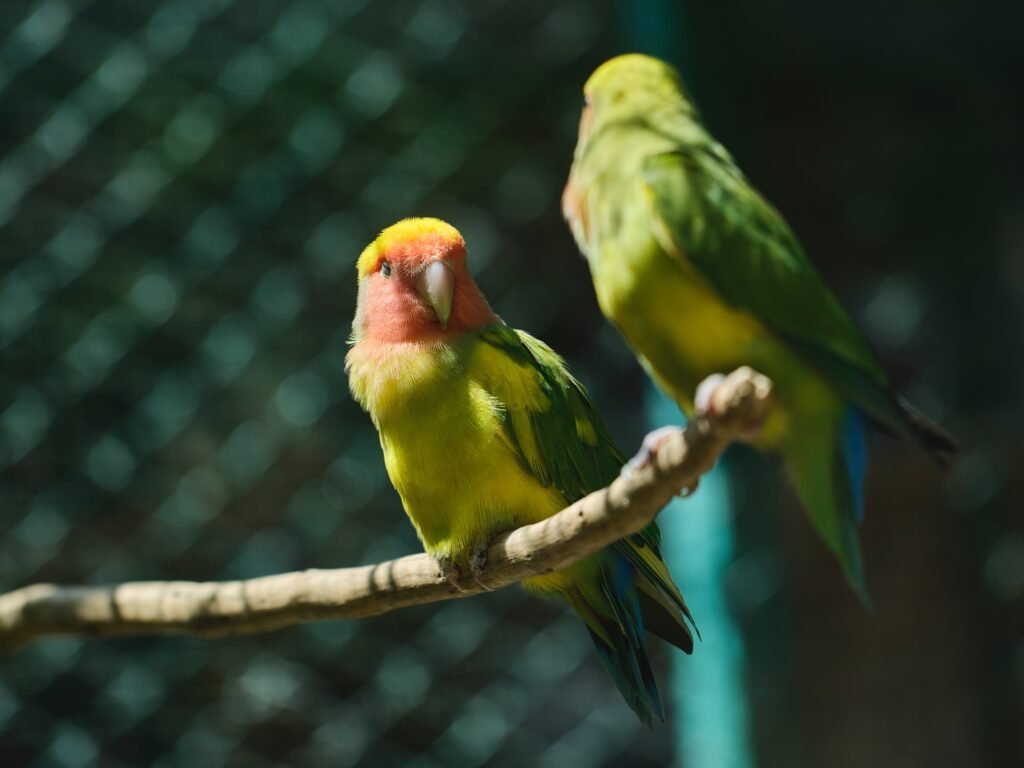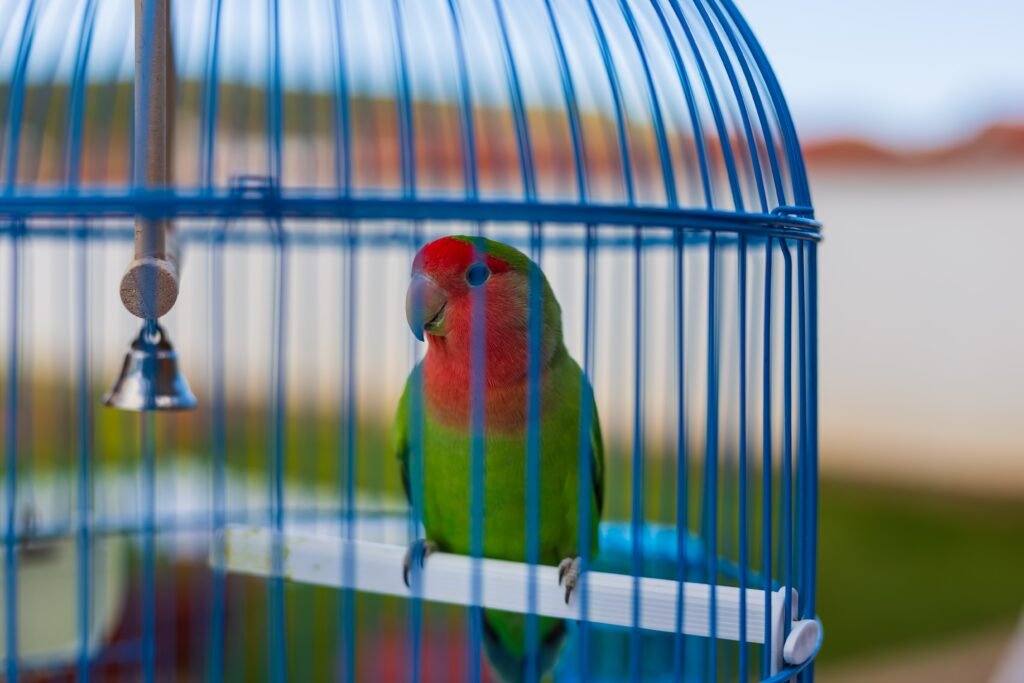Lovebirds are popular pets for their vibrant colours, playful personalities, and enchanting sounds. These small parrots are visually captivating and possess a wide range of vocalizations that they use to communicate with each other and their human companions. This article will delve into the fascinating world of lovebirds’ sounds, deciphering the melodies and chirps that make them unique.
Understanding Lovebirds Vocalizations
Lovebirds are highly vocal creatures, and their sounds can vary based on their species, age, gender, and individual personality. We can understand their emotions, needs, and overall well-being by deciphering their vocalizations. Let’s explore some of the common lovebird sounds and what they signify:
- Chirping and Singing
Lovebirds are known for their melodious chirps and songs, which they use to express contentment, happiness, and excitement. Their vocalizations can vary in intensity, pitch, and rhythm. It’s common to hear lovebirds chirping and singing early in the morning or during periods of high activity. These cheerful sounds indicate that your lovebird is in a good mood and enjoying its environment.
- Lovebirds’ chirping and singing serve as a form of self-expression, reflecting their positive emotions.
- The intensity of their vocalizations can give you an idea of how happy and engaged they are in their surroundings.
- Pay attention to the pitch and rhythm of their chirps and songs, as they can convey different levels of excitement and joy.
- Whistling and Mimicking
Lovebirds are natural mimics and can learn to whistle tunes or imitate certain sounds they hear regularly. If you find your lovebird whistling or mimicking sounds like a telephone ringtone, doorbell, or even your voice, it’s a testament to their intelligence and ability to learn. This behaviour is particularly prominent in hand-reared lovebirds with more exposure to human sounds.
- Whistling and mimicking are signs of a lovebird’s cognitive abilities and attempts to communicate and connect with their human companions.
- Their ability to imitate specific sounds shows their capacity for learning and adapting to their environment.
- This behaviour is more common in hand-reared lovebirds because they have been exposed to human sounds early.
- Screeching and Squawking
Like any other parrot species, lovebirds can sometimes be quite noisy. Screeching and squawking are usually associated with calling out for attention, expressing frustration, or seeking companionship. If your lovebird starts making loud and persistent noises, it may be trying to communicate its needs or desires. Social interaction, toys, and a stimulating environment can help alleviate excessive screeching.
- Screeching and squawking are lovebirds’ way of demanding attention, often indicating that they want interaction or companionship.
- These vocalizations may also signify frustration or discomfort, so assessing their overall environment and well-being is important.
- Engaging your lovebird in regular playtime and providing them with toys that encourage mental and physical stimulation can help reduce excessive screeching.
- Purring and Clicking
Lovebirds have unique sounds known as purring and clicking, often signs of contentment, relaxation, and affection. These soft, gentle sounds resemble a cat’s purr and indicate that your lovebird is comfortable and feels safe in its surroundings. It’s common to hear these soothing sounds when lovebirds are preening, cuddling, or enjoying gentle interactions with their mates or human companions.
- Purring and clicking are lovebirds’ ways of expressing happiness and relaxation.
- These sounds signify that your lovebird is comfortable and content in its environment.
- Pay attention to their body language while they make these sounds, as it can further indicate their level of comfort and trust.
Interpreting Lovebirds Sounds
While it’s essential to understand the general meanings behind lovebirds’ vocalizations, it’s equally important to consider their body language and overall context. By observing their accompanying behaviour and body postures, you can better interpret what your lovebird is trying to communicate. Here are some additional tips for deciphering lovebirds sounds:
- Pay Attention to Frequency and Intensity
The frequency and intensity of lovebirds’ sounds can explain their emotional state. Higher-pitched and more rapid sounds often indicate excitement or alarm, while lower-pitched and softer sounds suggest relaxation or contentment. By paying attention to these variations, you can gauge whether your lovebird feels happy, stressed, or needs attention.
- High-frequency and rapid sounds can indicate excitement or a sense of urgency.
- Lower-pitched and softer sounds often signify relaxation and contentment.
- By understanding the variations in frequency and intensity, you can better respond to your lovebird’s emotional needs.
- Note the Association with Actions
Lovebirds’ vocalizations are often linked with specific actions or events. For example, if your lovebird chirps joyfully while playing with its toys or interacting with you, it indicates their enjoyment. On the other hand, if they screech when their cage is covered or in response to a perceived threat, it may signify fear or a warning. Understanding the context is crucial in correctly interpreting their sounds.
- Pay attention to the specific actions or events that coincide with your lovebird’s vocalizations.
- Joyful chirping during playtime or interaction is a sign of happiness and engagement.
- Screeching in response to certain situations can indicate fear or a need for protection.
- Recognize Individuality
Each lovebird has its unique personality and vocal repertoire. While there are general patterns in lovebirds’ vocalizations, it’s essential to recognize and appreciate the individuality of your feathered friend. Observe your lovebird’s sounds, body language, and behaviour to understand its specific communication style. This will strengthen the bond between you and your lovebird and enhance your ability to respond to its needs effectively.
- Get to know your lovebird’s unique vocalizations and behaviours.
- Spend time observing their communication style to better understand their needs and emotions.
- Recognize that each lovebird is different, and adapt your interactions to ensure a strong bond.
Creating a Harmonious Environment
Lovebirds are social creatures that thrive in a harmonious and enriched environment. By creating a conducive living space, you can promote their well-being and happiness. Here are some tips for providing a nurturing environment for your lovebirds:
- Offer Social Interaction
Lovebirds are highly social and need regular interaction with their human companions or other lovebird companions. Spend time talking to, playing with, and training your lovebird to foster a strong bond. If you have a single lovebird, consider providing it with a mirror or a stuffed animal to help alleviate potential loneliness.
- Regular social interaction is crucial for the mental and emotional well-being of lovebirds.
- Engage in activities that promote bonding, such as talking, playing, and training.
- If you have a single lovebird, providing it with companionship through a mirror or a stuffed animal can help reduce feelings of loneliness.
- Provide Mental Stimulation
Lovebirds are intelligent creatures that require mental stimulation to stay engaged and entertained. Offer a variety of toys, puzzles, and activities that encourage their natural foraging instincts and provide mental enrichment. Rotate these toys regularly to prevent boredom and promote a stimulating environment.
- Mental stimulation is essential for preventing boredom and keeping lovebirds mentally active.
- Provide a variety of toys, puzzles, and activities that cater to their foraging instincts and intellectual curiosity.
- Regularly rotate their toys to keep them engaged and prevent monotony.
- Ensure Physical Exercise
Lovebirds are energetic birds that require ample physical exercise to maintain their health and vitality. Provide a spacious cage with room for flying and install perches at different heights to encourage movement and exploration. Regular out-of-cage time in a safe, supervised environment is also essential for their well-being.
- Lovebirds need opportunities for physical exercise to stay healthy and active.
- A spacious cage with multiple perches at varying heights allows them to engage in natural behaviours like flying and climbing.
- Regular out-of-cage time provides them with the necessary exercise and mental stimulation.
- Maintain a Consistent Routine
Lovebirds thrive on routine and predictability. Establish a consistent schedule for feeding, social interaction, and rest to provide a sense of security and stability. Consistency in their daily routine helps create a stress-free environment and contributes to their happiness.
- Lovebirds feel secure and comfortable when they have a consistent routine.
- Establish a schedule for feeding, social interaction, and rest to provide stability.
- Consistency in their daily routine promotes a stress-free environment and enhances their well-being.
In conclusion, lovebirds’ sounds are enchanting and serve as a means of communication. Understanding and interpreting their vocalizations can better meet their emotional, social, and environmental needs. By creating a harmonious and stimulating environment, we can ensure that our lovebirds lead happy and fulfilling lives as our cherished companions.
Lovebirds Sounds: Deciphering the Melodies and Chirps of Lovebirds – FAQ
- What do lovebirds’ chirping and singing signify?
Lovebirds’ chirping and singing serve as a form of self-expression, reflecting their positive emotions. Their vocalizations’ intensity, pitch, andvocalizationsndicate their excitement and joy.
- What does it mean when lovebirds whistle and mimic sounds?
Whistling and mimicking are signs of a lovebird’s cognitive abilities and attempts to communicate and connect with their human companions. It shows their capacity for learning and adapting to their environment.
- Why do lovebirds screech and squawk?
Screeching and squawking are lovebirds’ ways of demanding attention, often indicating that they want interaction or companionship. These vocalizations also signify frustration or discomfort, so assessing their environment and well-being is important.
- What do purring and clicking sounds mean in lovebirds?
Purring and clicking are lovebirds’ ways of expressing happiness and relaxation. These sounds signify that your lovebird is comfortable and content in its environment. Pay attention to their body language while they make these sounds, as it can further indicate their level of comfort and trust.
.


